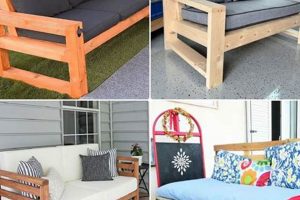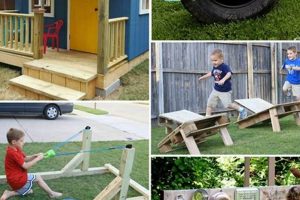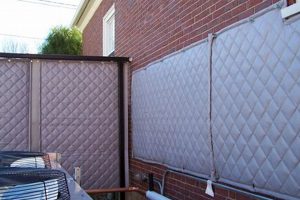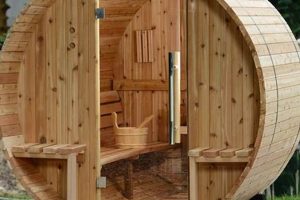The construction of custom exterior furnishings from cement offers an avenue for homeowners to personalize their outdoor spaces. Such projects typically involve mixing cement with aggregates, pouring the mixture into a mold of the desired shape and size, and allowing the concrete to cure and harden. For instance, one might create a surface suitable for dining or entertaining by using a wooden form to cast a rectangular concrete slab, supported by legs crafted from wood or metal.
This approach to outdoor furniture creation provides numerous advantages. Cement’s inherent durability ensures resistance to weathering and physical damage, resulting in long-lasting pieces. The substantial weight of cement confers stability, mitigating the risk of tipping or movement in windy conditions. Historically, cement has been utilized as a construction material for millennia, valued for its strength and versatility. Employing it in this manner allows for cost-effective creation of durable, personalized outdoor elements.
The following discussion will delve into the specific materials, tools, and techniques required for successful execution. Considerations such as mold design, reinforcement strategies, and finishing options will be addressed to facilitate the construction of functional and aesthetically pleasing outdoor furnishings.
Construction Recommendations for Cement-Based Exterior Surfaces
Adherence to best practices is crucial for achieving structurally sound and aesthetically pleasing cement-based outdoor surfaces. The following recommendations outline essential considerations for successful fabrication.
Tip 1: Mold Integrity: Ensure mold construction is robust and watertight. Cement slurry will exploit any weakness, resulting in undesirable blemishes on the finished product. Utilize sealing agents at seams and junctions to prevent leakage.
Tip 2: Reinforcement Implementation: Incorporate reinforcement such as rebar or wire mesh within the cement matrix. This enhances tensile strength and mitigates cracking due to thermal expansion, contraction, or applied loads.
Tip 3: Proper Mixing Ratios: Strictly adhere to recommended water-to-cement ratios. Excess water weakens the final product, while insufficient water hinders proper hydration and strength development.
Tip 4: Curing Protocol: Implement a consistent curing process. Maintain moisture levels for an extended period (typically 7-28 days) to facilitate complete cement hydration and maximize strength. Cover the surface with plastic sheeting or apply a curing compound.
Tip 5: Vibration for Consolidation: Employ vibration techniques to eliminate air pockets trapped within the cement mixture. This enhances density and improves surface finish. Caution must be exercised to avoid over-vibration, which can lead to segregation.
Tip 6: Surface Finishing Techniques: Explore various finishing techniques to achieve the desired aesthetic. Options include polishing, staining, sealing, and texturing. Consider the intended use and exposure conditions when selecting a finish.
Tip 7: Adequate Drainage: Design the surface with a slight slope to facilitate water runoff. This prevents ponding, which can lead to staining, cracking, and accelerated deterioration.
Successful execution relies on meticulous planning and attention to detail. Following these guidelines will enhance the likelihood of creating durable and visually appealing outdoor furnishings.
The subsequent section will address common challenges encountered during cement construction and provide troubleshooting strategies for mitigating potential issues.
1. Cement Composition
The selection of cement composition is a foundational element in the creation of a durable and aesthetically pleasing exterior cement surface. It directly influences workability, strength, setting time, and ultimately, the resistance of the finished piece to environmental factors. Using an inappropriate cement type can lead to structural failures, surface degradation, and a significantly shortened lifespan for the constructed item. For instance, a high-early-strength cement might be chosen when rapid setting and early use are priorities. In contrast, a general-purpose cement could be more suitable for large castings where extended working time is desired. Cement composition also dictates resistance to sulfate attack and alkali-silica reaction, crucial considerations in regions with specific soil or environmental conditions.
Variations in cement blends affect color and texture. Portland cement, the most common type, produces a gray hue. The addition of pigments, aggregates, or supplementary cementitious materials, such as fly ash or slag, modifies the visual appearance and can enhance properties like permeability and workability. Proper mix design, including careful consideration of the cement-to-aggregate ratio and the water-cement ratio, is vital for optimizing strength and minimizing shrinkage cracking. A mix too rich in cement may be prone to cracking, while a mix with insufficient cement will lack the necessary strength and durability for outdoor exposure. Therefore, understanding the characteristics and performance specifications of different cement compositions is fundamental to a successful cement-based furniture project.
In summary, the choice of cement composition and mix design is not merely a technical detail; it’s a critical decision impacting the structural integrity, longevity, and aesthetic outcome. Ignoring these factors risks compromising the entire project, resulting in costly repairs or premature failure. A comprehensive understanding of cement types and their interaction with other materials is paramount for producing a reliable and attractive exterior surface.
2. Mold Construction
Mold construction represents a critical phase in the creation of exterior cement surfaces, directly determining the final dimensions, shape, and surface quality. The integrity of the mold dictates the precision and aesthetic appeal achievable in the finished project.
- Material Selection
The choice of mold material impacts both the ease of construction and the final surface finish. Common materials include wood, melamine-coated particleboard, and specialized plastic sheets. Wood offers affordability but requires careful sealing to prevent moisture absorption and surface imperfections. Melamine provides a smooth, non-porous surface but may be less durable for repeated use. Plastic sheets offer flexibility and can be custom-formed but might necessitate additional support to maintain structural integrity. Material selection is dictated by the complexity of the intended form and the desired level of surface detail.
- Structural Rigidity
A structurally rigid mold is essential for preventing deformation during the pouring and curing processes. Cement exerts considerable pressure as it cures, and any weakness in the mold’s construction can lead to bulging or warping, resulting in dimensional inaccuracies and surface defects. Reinforcement with external bracing or internal supports is often necessary, particularly for larger or more intricate designs. The mold must withstand the hydrostatic pressure exerted by the cement slurry to maintain its intended shape.
- Seam Sealing
Effective seam sealing is crucial to prevent cement slurry from leaking and creating undesirable fins or blemishes on the finished surface. Caulking compounds or specialized tapes are employed to create a watertight barrier at all joints and seams. The choice of sealant must be compatible with the mold material and resistant to the alkalinity of cement. Thorough and meticulous seam sealing minimizes the need for post-casting repairs and ensures a clean, well-defined edge.
- Draft Angles and Demolding
Incorporating slight draft angles into the mold design facilitates the demolding process. These angles, even a few degrees, prevent the cement from locking into the mold and allow for easier removal of the finished piece without damaging the edges or surfaces. Applying a releasing agent, such as form oil or a wax-based coating, further assists in demolding. Consideration of demolding techniques during mold construction is essential to avoid complications during the final stages of the project.
These facets of mold construction are integral to the successful fabrication of cement-based exterior surfaces. A well-designed and constructed mold provides the foundation for a durable, aesthetically pleasing, and structurally sound product. Ignoring these critical aspects can lead to defects, inefficiencies, and a compromised final outcome.
3. Reinforcement Integration
Reinforcement integration is a paramount consideration in the creation of a cement-based outdoor surface. The incorporation of reinforcing materials mitigates the inherent brittleness of cement, enhancing its ability to withstand tensile stresses and preventing catastrophic failure due to cracking.
- Tensile Strength Enhancement
Cement, while strong in compression, possesses limited tensile strength. Reinforcement, typically in the form of steel rebar or wire mesh, provides tensile strength to the composite material. This allows the created outdoor surface to resist bending forces and tensile stresses induced by weight or thermal expansion/contraction. Without such reinforcement, the cement structure will be susceptible to cracking and eventual structural compromise.
- Crack Propagation Control
Even with reinforcement, minor cracks can develop in the cement matrix. However, properly integrated reinforcement serves to control the propagation of these cracks. The reinforcement intercepts and arrests the spread of cracks, limiting their size and preventing them from widening to a point where they weaken the overall structure. This localized control significantly extends the service life and maintains the structural integrity of the cement surface.
- Material Selection and Placement
The selection of reinforcement material and its proper placement within the cement matrix are crucial. Steel rebar offers high tensile strength and is suitable for large surfaces requiring significant load-bearing capacity. Wire mesh provides distributed reinforcement and is ideal for thinner slabs or surfaces subjected to moderate stresses. Reinforcement should be positioned within the lower section of the slab where tensile stresses are greatest, ensuring optimal resistance to bending forces. Proper spacing and coverage are essential to maximize the effectiveness of the reinforcement.
- Corrosion Prevention
Steel reinforcement is susceptible to corrosion, particularly in outdoor environments. Corrosion weakens the steel and can lead to cracking of the surrounding cement due to the expansion of corrosion products. Measures to prevent corrosion include using epoxy-coated rebar, increasing the cement cover over the reinforcement, and incorporating corrosion inhibitors into the cement mix. These precautions extend the lifespan of the reinforcement and prevent structural degradation of the cement surface.
These considerations are essential for ensuring the long-term durability and structural stability of exterior cement surfaces. The absence of adequate reinforcement or improper integration of reinforcing materials significantly compromises the functionality and lifespan. Careful attention to these factors guarantees a robust and enduring finished product.
4. Curing Process
The curing process is intrinsically linked to the structural integrity and longevity of a cement-based outdoor surface. Hydration, the chemical reaction between cement and water, continues for an extended period after the initial set. Proper curing involves maintaining adequate moisture and temperature to facilitate complete hydration, resulting in a denser, stronger, and more durable final product. Inadequate curing leads to reduced strength, increased permeability, and heightened susceptibility to cracking, particularly in exterior applications exposed to fluctuating temperatures and moisture levels. The quality of the curing process, therefore, directly dictates the performance and lifespan of a table constructed using cement.
Different curing methods exist, each offering varying degrees of effectiveness and practicality. Water curing, involving continuous wetting or submersion, provides optimal moisture retention but may be challenging for large or complex structures. Membrane curing, utilizing a liquid compound to seal the surface and prevent moisture evaporation, offers a more convenient alternative but requires careful application to ensure uniform coverage. The choice of curing method should align with the specific project requirements, environmental conditions, and available resources. For instance, in arid climates, prolonged water curing or the use of multiple layers of membrane curing compound may be necessary to mitigate rapid evaporation. Failure to adapt the curing process to the environment can compromise the cement’s hydration and ultimately weaken the overall structure. Consider a diy cement surface exposed to direct sunlight and high winds: if not adequately cured, it is likely to develop surface cracks and experience reduced flexural strength.
In conclusion, the curing process is not merely a procedural step but a critical determinant of the final product’s quality and resilience. Effective curing optimizes cement hydration, minimizes cracking, and enhances resistance to environmental stressors, ensuring the durability and long-term performance of a cement-based outdoor table. A thorough understanding of curing principles and careful implementation of appropriate techniques are essential for successful execution. Neglecting this vital process can result in structural weaknesses and a significantly shortened lifespan for the created item.
5. Surface Finishing
Surface finishing profoundly impacts the aesthetic appeal, durability, and functionality of a exterior cement surface. This process extends beyond mere aesthetics, significantly influencing resistance to weathering, staining, and abrasion. Properly executed surface finishing techniques protect the cement matrix, minimizing the ingress of moisture and contaminants that can lead to deterioration, cracking, or spalling. For a exterior cement surface, adequate sealing is crucial to withstand exposure to rain, UV radiation, and freeze-thaw cycles. The choice of finishing technique directly affects the table’s longevity and its ability to maintain its appearance over time.
Various surface finishing options exist, each conferring distinct characteristics. Polishing creates a smooth, refined surface, enhancing stain resistance and ease of cleaning. However, highly polished surfaces can become slippery when wet, posing a safety concern. Sealing with penetrating sealers provides protection against moisture and staining without altering the surface texture. Staining allows for customization of color and appearance, mimicking natural stone or achieving a contemporary aesthetic. Texturing techniques, such as sandblasting or acid etching, create a non-slip surface and add visual interest. A project that uses a smooth finish might require a non-slip sealer, balancing both the aesthetic and safety aspects. The selection of a finish necessitates careful consideration of the intended use, environmental conditions, and desired aesthetic.
In summary, surface finishing is an indispensable step in the construction of a cement-based exterior table. It serves not only to enhance visual appeal but also to safeguard the cement matrix against degradation, extending the table’s lifespan and ensuring its continued functionality. Thoughtful selection and skilled application of surface finishing techniques are essential for creating a durable, attractive, and functional addition to any outdoor space.
6. Structural Support
Structural support is a non-negotiable element in the fabrication of a cement-based outdoor table. The inherent weight and rigidity of cement necessitate a robust support system capable of withstanding static and dynamic loads while maintaining stability and preventing catastrophic failure. The design and implementation of structural support directly influence the functionality, safety, and longevity of the finished piece.
- Load Distribution and Stability
The primary function of structural support is to distribute the weight of the cement tabletop evenly across the supporting structure and onto the ground. An inadequate support system results in concentrated stress points, leading to cracking, warping, or even collapse. For instance, a large cement surface requires multiple support points to prevent sagging in the middle. The design must consider the anticipated load, including the weight of the cement, any objects placed on the surface, and potential external forces such as wind or impact. Stability is achieved by ensuring a wide base of support and a low center of gravity, minimizing the risk of tipping or movement.
- Material Selection for Support Structures
The choice of materials for the support structure is crucial for its durability and compatibility with the cement tabletop. Common materials include steel, wood, and cement itself. Steel offers high strength and corrosion resistance but requires welding or specialized fasteners for assembly. Wood provides a more readily workable option but is susceptible to rot and insect infestation if not properly treated. Cement support structures, cast in place or pre-fabricated, offer a cohesive aesthetic and similar material properties to the tabletop but add significant weight to the overall assembly. The selection depends on factors such as budget, aesthetic preferences, and environmental conditions.
- Connection Methods and Integration
The method of connecting the tabletop to the support structure is vital for ensuring a secure and stable assembly. Mechanical fasteners, such as bolts or screws, can be used to attach the tabletop to a steel or wood frame. Adhesives, specifically formulated for bonding cement to other materials, offer a clean and seamless connection but require careful surface preparation and application. A cement-to-cement connection, achieved through casting the tabletop directly onto a pre-existing cement base, creates a monolithic structure with maximum strength and stability. The integration method must account for differential thermal expansion between the cement and the support material to prevent stress fractures.
- Design Considerations for Aesthetics and Functionality
The structural support system should not only provide adequate load-bearing capacity but also complement the overall design aesthetic and functionality of the table. A minimalist steel frame can create a sleek and modern look, while a rustic wooden base adds warmth and character. The height and shape of the support structure influence the usability and comfort of the table. For example, a higher table requires taller support legs, while a wide table needs a broader base for stability. The design should consider accessibility for users, ensuring adequate legroom and clearance. The structural support, therefore, plays a dual role: providing essential stability and enhancing the overall appeal and practicality of the finished cement surface.
In summary, structural support is a foundational element in the construction of a durable and functional cement-based outdoor table. The design, material selection, and integration methods directly influence the table’s stability, longevity, and aesthetic appeal. A well-engineered support system not only provides the necessary load-bearing capacity but also complements the overall design, creating a lasting and enjoyable addition to any outdoor space.
7. Weather Resistance
A fundamental requirement for any outdoor structure, weather resistance dictates the lifespan and sustained aesthetic quality of a cement surface. Environmental factors, including precipitation, temperature fluctuations, and ultraviolet (UV) radiation, exert continuous stress on outdoor materials. A cement-based surface, while inherently durable, is still susceptible to degradation from these elements. Without adequate weather resistance, a table may experience cracking from freeze-thaw cycles, staining from prolonged exposure to moisture, and discoloration from UV radiation. The structural integrity and visual appeal of the completed project is severely compromised if it cannot withstand such exposures.
Achieving weather resistance involves a multi-faceted approach. Proper cement mix design, including the selection of appropriate aggregates and admixtures, is critical for minimizing permeability and enhancing resistance to freeze-thaw damage. Surface sealing with specialized products creates a protective barrier against moisture penetration and staining. The inclusion of UV-resistant pigments helps to prevent discoloration and fading. Adequate drainage design, allowing for water runoff, minimizes prolonged exposure to moisture. Failure to address any of these elements weakens the table’s ability to withstand the elements. For instance, a surface lacking a proper sealant may absorb moisture, leading to spalling and cracking during winter months. UV exposure will also cause unprotected surfaces to fade.
In conclusion, weather resistance is not merely a desirable attribute, but an essential characteristic. Prioritizing weather resistance during all phases, from material selection to finishing techniques, is crucial for ensuring the long-term viability. The understanding and proper implementation of strategies will lead to a durable, visually appealing, and structurally sound outdoor cement surface capable of enduring the rigors of the environment. The longevity of any surface is a direct reflection of its capacity to resist weathering effects.
Frequently Asked Questions About Cement-Based Exterior Surfaces
The following questions address common inquiries and concerns regarding the design, construction, and maintenance of such surfaces. These questions should aid in informed decision-making and promote successful project outcomes.
Question 1: What is the optimal cement mix ratio for exterior applications?
The ideal ratio depends on the intended use and environmental conditions. A general guideline is a 1:2:3 ratio of cement to sand to aggregate, respectively. However, this may vary based on the specific properties of the chosen materials and the desired strength and workability. Consultation with a structural engineer or experienced contractor is advised.
Question 2: How can cracking be minimized in large cement slabs?
Cracking is a common concern in large cement slabs. Minimization strategies include incorporating reinforcement (rebar or wire mesh), using control joints to manage stress concentrations, employing proper curing techniques, and selecting a low-shrinkage cement mix. Fiber reinforcement may also prove beneficial in reducing cracking.
Question 3: What type of sealant is best suited for exterior cement?
The selection of a sealant should be based on its resistance to UV radiation, water penetration, and abrasion. Penetrating sealers, which permeate the surface and create a hydrophobic barrier, are generally preferred over film-forming sealers, which can be susceptible to peeling and cracking. Sealants should be reapplied periodically to maintain their protective properties.
Question 4: How should cement surfaces be prepared for cold weather?
Cold weather can significantly impact the curing process. Protecting fresh cement surfaces from freezing temperatures is critical to prevent damage. Methods include covering the surface with insulating blankets, using heated enclosures, and employing accelerating admixtures to hasten the curing process. Avoid pouring cement when temperatures are below freezing.
Question 5: What are the common causes of staining on cement surfaces?
Staining can result from various sources, including organic matter (leaves, dirt), mineral deposits (rust, hard water), and chemical spills. Prevention involves applying a sealant, promptly cleaning spills, and ensuring adequate drainage. Specific stain removal techniques vary depending on the nature of the stain. Power washing can remove grime from surfaces.
Question 6: How can the appearance of cement be customized?
Cement surfaces can be customized through various techniques, including adding pigments to the mix, using decorative aggregates, applying stencils or stamps, and employing specialized finishing methods such as polishing or acid etching. Color hardeners provide a durable and aesthetically pleasing surface for outdoor applications.
Understanding these considerations is paramount for constructing durable and visually appealing outdoor cement surfaces. Consult local building codes and engage qualified professionals when necessary.
The following article will provide a conclusion to cement-based exterior surface elements.
Conclusion
The preceding exploration elucidated the essential considerations for constructing a exterior cement surface. From cement composition and mold construction to reinforcement integration, curing processes, surface finishing, structural support, and weather resistance, each element contributes critically to the final product’s durability, functionality, and aesthetic appeal. Diligent attention to these factors is not merely a matter of best practice but a prerequisite for achieving a long-lasting and structurally sound result. A project undertaken without a comprehensive understanding of these principles risks premature failure and costly remediation.
The pursuit of a handcrafted exterior furnishing represents a significant undertaking. However, the knowledge imparted within this resource empowers individuals to approach such projects with increased confidence and competence. Continued research, diligent planning, and adherence to established guidelines will serve to realize durable structures that enhance the use of outdoor spaces and enduring aesthetic appeal for years to come.







